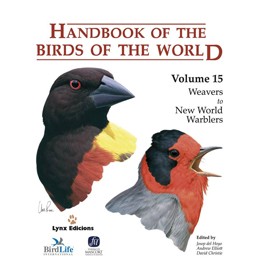| Serie | |
| Autoren | Josep del Hoyo, Andrew Elliott, David A. Christie |
| Sprache | Englisch |
| ISBN | 9788496553682 |
| Verlag | Lynx Ediciones |
| Seiten | 879 |
| Größe | 31 x 24 cm |
| Format | Gebunden |
| Bilder | Reich illustriert, volle Farben |
| Erscheinungsjahr | 2010 |
The authors of the Foreword titled “Conservation of the World’s Birds: The View from 2010” are Stuart Butchart, Nigel Collar, Alison Stattersfield and Leon Bennun from Birdlife International. They provide a well-documented summary of the many threats that hang over bird diversity and populations as a result of the human imperative for development at any cost, and they also lay out efforts and recommendations aimed at slowing down what seems an unstoppable process.
This volume includes 8 families and a total of 606 species. It begins with the weavers of Africa and south Asia, which construct the most elaborate and complex nests of all birds (there are colonies of Red-billed Quelea of more than 30 million nests!). Whydahs and indigobirds follow, endemic to tropical Africa and parasitic of the nests of birds of the family of the waxbills. These last are brightly coloured and well known as caged birds. They are present from tropical Africa to the Pacific Ocean islands.
The New World is also represented, with the vireos, the critically threatened Hawaiian honeycreepers, the Olive Warbler and New World warblers. In addition we have the finches family, the largest in the volume with 144 species, among which are some of the best-known and most widely distributed birds in the world, such as the European Goldfinch and the domestic Island Canary.
Order PASSERIFORMES
Family Ploceidae (Weavers)
Family Viduidae (Whydahs and Indigo Birds)
Family Estrildidae (Waxbills)
Family Vireonidae (vireos)
Family Fringillidae (Finches)
Family Drepanididae (Hawaiian honeycreepers)
Family Peucedramidae (Olive Warbler)
Family Parulidae (New World Warblers)































